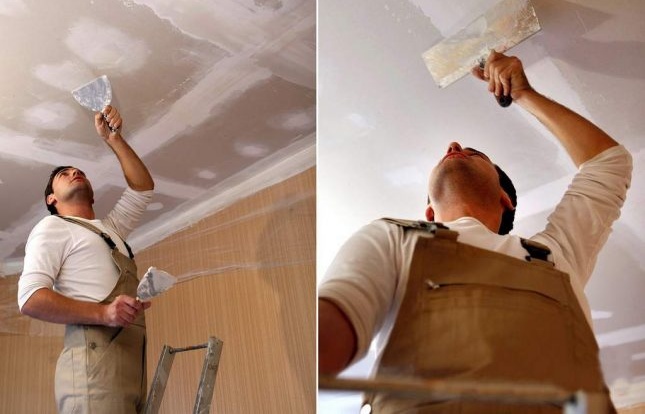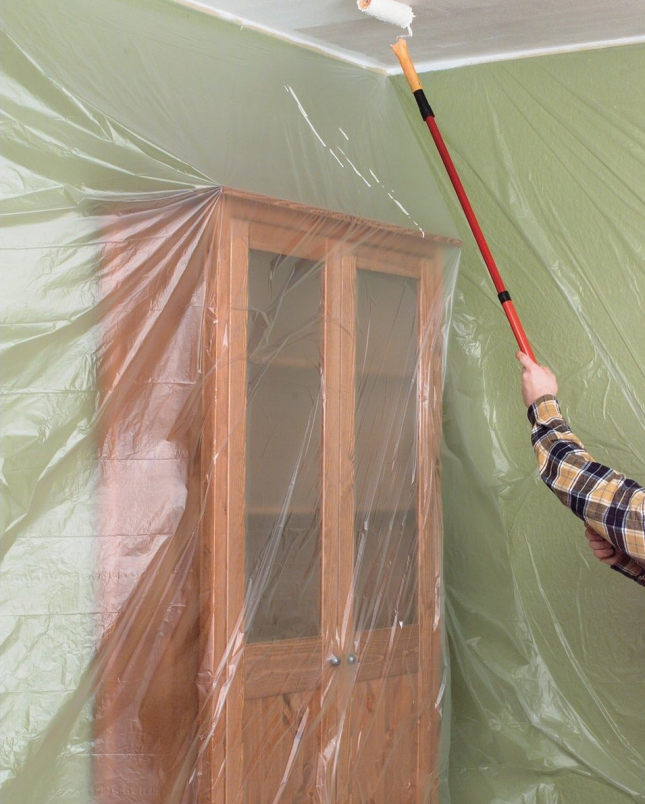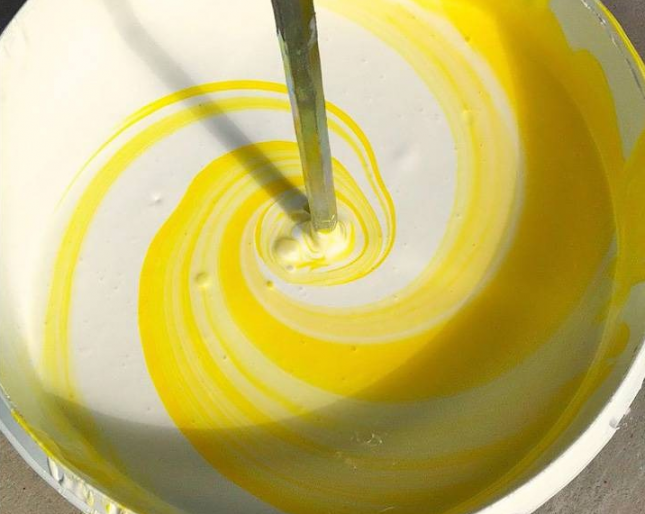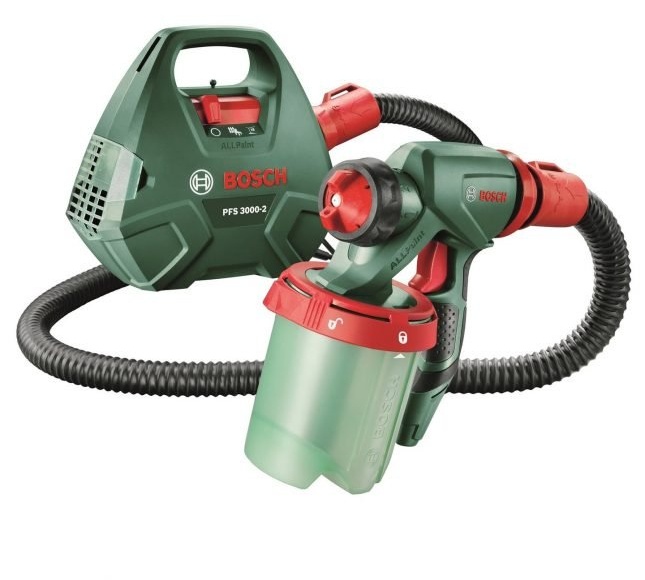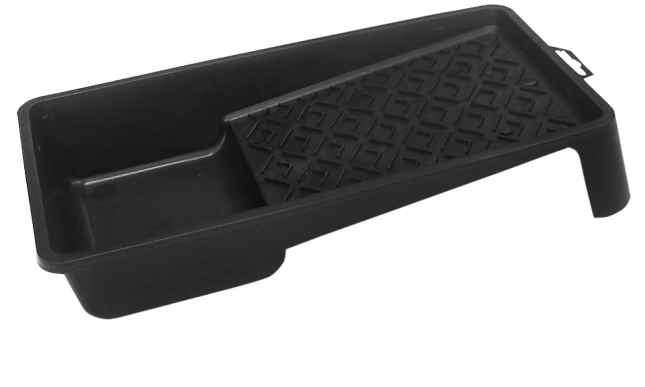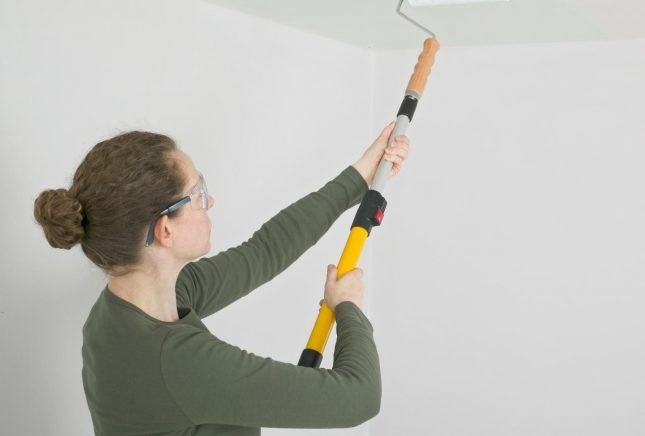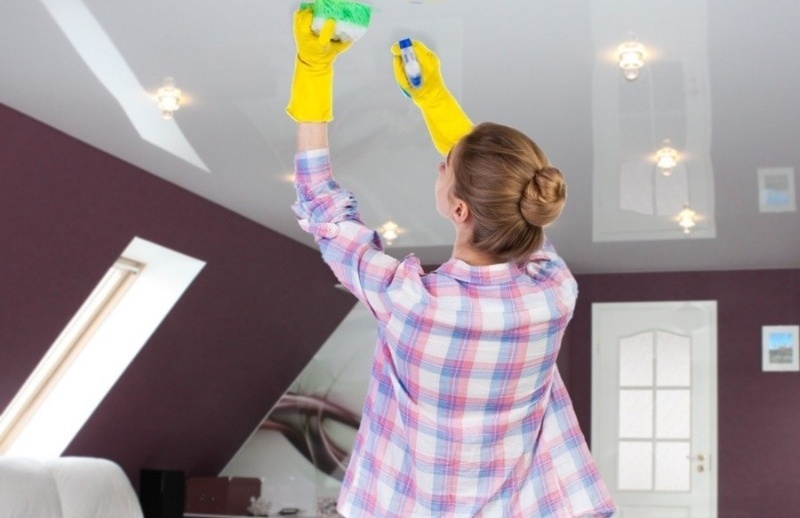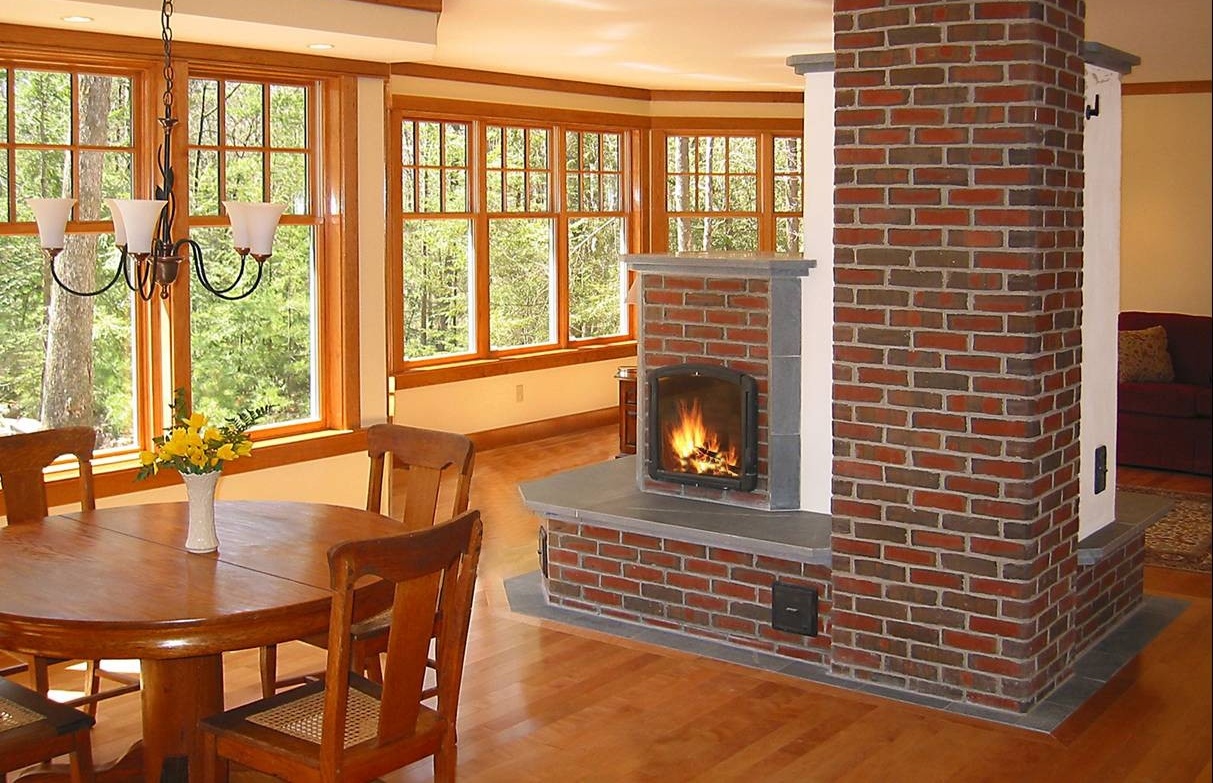We paint the ceiling with a water-emulsion painting - the secrets of painting art
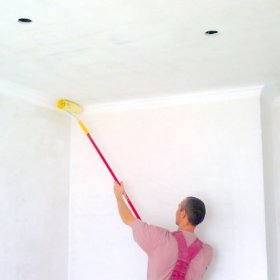
Repair is often a long and multitasking process, requiring a lot of investment of time, effort and money. One of the final stages of construction is the painting of surfaces, including the ceiling. For interior decoration, water-based paint is most often used, it is applied to a previously prepared surface in several layers. There are a huge number of technologies and principles of painting the ceiling, so this issue should be addressed in advance.
Content
Preparatory work
In order for the ceiling to look good at the end of the work, it is necessary to qualitatively prepare it for painting. This will protect the coating from cracks, fungus, stains, stains and other nuances that spoil the appearance of the repair. Depending on the type of ceiling (drywall, plaster, concrete), the features of the preparation of the coating may vary, however, the principle of their implementation remains the same.
Finishing the surface
To paint lay evenly without streaks and patches, it is necessary to apply it on a perfectly smooth, clean ceiling. This can be achieved by puttying, grinding and priming. Consider the action algorithm for a drywall surface:
- We carry out the primer of the ceiling.
- We seal the seams between the sheets with a special mesh (serpyanka), and then cover them with a starting putty.
- We apply the first layer of thick-walled gypsum plaster (starting putty) to the entire ceiling.
- We prime the ceiling, after a while we put glue on its entire surface, and then glue the fiberglass canvas (this will protect the surface from cracking in the future, which is unacceptable for painted ceilings).
- We put a layer of finishing putty on top of the reinforcing canvas.
- If necessary, use sanding paper to remove the sag and achieve a perfect plane.
- Using a slightly damp cloth, remove dust and chips from the ceiling.
- We carry out the final primer of the ceiling before painting.
If the ceiling in the house or apartment is made of concrete ceilings, then the procedure for preparatory actions before painting it is as follows:
- Primed surface.
- We close the seams between the plates with reinforcing tape.
- We apply the first layer of gypsum plaster to remove large depressions.
- We apply the second layer of finishing putty.
- Using sanding paper, remove irregularities.
- We prime the ceiling before painting it.
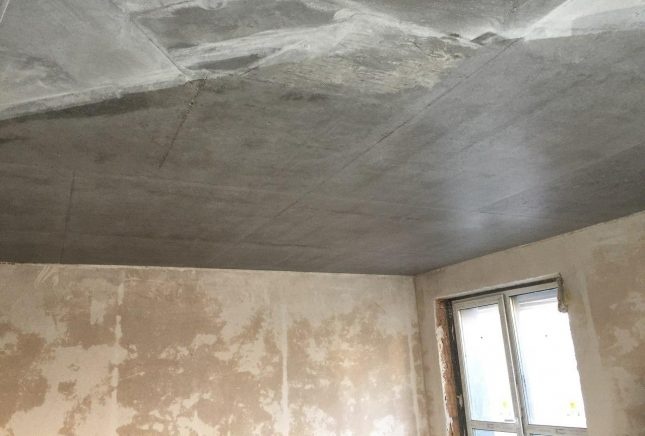
That the paint on the concrete ceiling did not crack over time, the joints of the plates must be covered with reinforcing tape
Preparation of the painted surface
If there is already paint on the ceiling and there is a need to simply update it, the algorithm of preparatory actions before painting has a different character. It all depends on what paint was originally applied, if it is a good, expensive water-based paint, then there is no difficulty in preparing such a ceiling. In this situation, it is required to prime the ceiling in two layers, after which a new coat of paint can be applied. If initially the paint was cheap (acrylic emulsion of water, lime, whitewash), then you have to remove it, for this you can use the following instruction:
- Pour hot water into the basin (60–70about) and with a roller, like a primer, apply water to the painted ceiling.
- After 15 minutes, repeat the procedure, soaking old paint with a layer of hot water.
- After another 10–20 minutes, with the help of a spatula, remove the old water emulsion, which, after getting wet, peels off with rags.
- After the ceiling has completely dried, we ground it.
- In the process of removing old paint with a spatula, the putty layer is damaged, so a new layer of finish putty must be applied to the ceiling.
- We apply the primer to the ceiling, after which it can be painted again.
- This surface is painted in the same way as a fine one.

If the ceiling is already painted with an inexpensive water-based emulsion, then before applying a new one it will have to be removed
How to choose a primer
A primer is a colorless or slightly transparent material in liquid form, which is designed to improve the adhesion (gluing) of materials. Most primers have additional antiseptic properties that protect surfaces and materials from the appearance of fungus. There are a huge number of types of material, but if we are talking about painting the ceiling with water-based paint, then the selection will not be difficult. In order for the paint to lay down well, you can do with a universal or strengthening primer. It has a milky color, does not smell, does not leave a film, it can be used not only to prepare the ceiling for painting, but also to improve the bonding properties of two layers of putty (finish and start).
Some builders use the "grandfather method" and replace the primer with PVA glue diluted with water. This is a good tool that provides excellent adhesion of the putty with paint, does not have an unpleasant odor and does not harm the health of people living in the room during the repair. To prepare a home-made primer, pour PVA glue into the container and mix it with water, quickly mixing the composition. During mixing, it is necessary to achieve the consistency and color of milk so that the soil is not too thick or too liquid.
How to prepare a room for painting
Before you start painting the ceiling, you need to carry out a number of preparatory measures:
- Remove foreign objects from the room. If there is furniture left in the room, and the tools that were used at the previous stage of repair, they should be removed or covered with a protective cloth or film.
- Cover the floor. The floor is covered with roll paper, you can use old wallpaper or film. The joints of two canvases are glued with adhesive tape, she also fixes a protective coating to the baseboards or the bottom of the wall.
- Protect the walls. Even if the walls are plastered and prepared for painting, they should be protected so that in the future there would be no difficulties with the finish. The walls are covered with a special film, which is glued under the ceiling skirting board and pulled down, forming a solid protective layer.
- Protect windows and doors. Window and doorways are also covered with film, sheets or any other materials that can hide them from paint.
Essential tool
To perform all types of repair work, a specialized tool is required, including for painting the ceiling. First of all, you should take care of personal protective equipment:
- glasses that protect the mucous membrane of the eye from paint;
- disposable film hoodie with a hood that covers the whole body and protects clothing from paint. You can use a raincoat and a disposable medical cap for hair;
- rubber or cloth rubberized gloves;
- a respirator that protects the respiratory system from paint fumes and building dust.
When painting the ceiling, the following tools may be helpful:
- a thin brush for working hard areas;
- a roller with a telescopic or long handle;
- special tray for paint;
- capacity with clean water;
- an object for mixing paint (it can be a stick, spoon, long brush);
- rags for removing paint;
- feathering sponge;
- the paint itself.
Which roller to choose
All rollers for painting work significantly differ from each other by the material of the tube coat and its width. For painting the ceiling with a water emulsion, rollers of medium size (10–20 centimeters) are best suited. As for the fur coat, it is necessary to give preference to fleecy rollers (from microfiber, wool or polyamide), which are made from natural and synthetic materials. They allow you to give the paint a texture and paint uneven planes. The main criterion for a good fleecy roller is the material's resistance to paint and the density of the packing. Hair should not fall out of the tool, even if they are pulled with force, otherwise the ceiling after painting will look like a carpet. A short pile is suitable for light colors, and a long pile for bright and dark colors. For ease of use, you should take care of the handle; when working with the ceiling, you should additionally purchase a telescopic handle that allows you to paint the ceiling while standing on the floor.
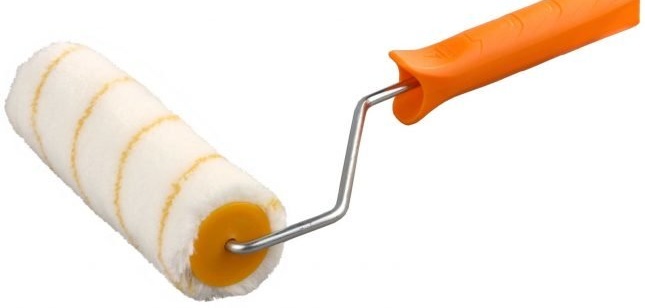
High-quality fleecy roller allows you to apply paint to the ceiling texture, staining even the surface with irregularities
What emulsion paint to use for the ceiling
Water emulsion is a modern universal paint based on a water emulsion, which does not have a pungent odor or toxic emissions. All paints of this type can be divided into 4 main groups relative to the main component of the composition:
- latex. It is based on latex essence, which makes the paint thick and elastic. This water emulsion can be applied in a single layer and, after drying, subjected to wet cleaning. This option is ideal for painting ceilings in living rooms (NanoFarb Latex, CityColor CityPlast);
- silicone. The composition contains silicone resins that provide good moisture protective properties to the paint, and also allow it to be applied to surfaces that are prone to cracking. The cost of this water-based paint is higher than others. It is used for painting ceilings and walls in rooms with high humidity, as well as severe changes in temperature conditions (Capasilan, Teknos Siloksan);
- acrylic. The most affordable paint, it is based on acrylic copolymers, allowing you to give the painted surface a texture. This type of paint is easily washed off with water and dries quickly after application. Acrylic water emulsion has the maximum number of preset tones, it is used for painting walls and ceilings in dry rooms (Eskaro Mattilda, Color Standart);
- silicate. It contains liquid glass, which gives the painted surface additional durability. It is used for painting facades and technical rooms (pantries, garages). The composition easily lays on wooden, concrete and stone surfaces (Biofa Solimin, Vivacolor Hansa Silicate).
How to paint a ceiling with water-based paint
There are several options for painting the ceiling, depending on the equipment used. It is possible to apply a water emulsion to the surface mechanically (using a roller and brush) or in hardware (using special compressor pulverizers). To paint lay evenly and there is no need to redo the work, you should use these recommendations:
- water-based paint can be diluted with water, but this is not always necessary. Such a need may arise if the composition has a high viscosity or the paint material will be applied using a spray gun. Paint is diluted with purified water in a proportion of 100 milliliters of water per 1 liter of paint. Water should have a temperature of 25-30about, after adding it to the paint, the mass must be mixed with a mixer or nozzle on a drill. A few minutes later, after the air bubbles are gone, the paint is ready for use;
- it is necessary to tint the paint gradually; you cannot immediately pour the entire contents of the container with the dye into a jar. Color should be added in small portions, while mixing the mass with a mixer at low speed. To paint the ceiling in one room, you need to tint a little more paint than necessary, since if there is not enough paint a little, it will be almost impossible to achieve the same shade again;
- paint is always applied in at least two layers, while the layers must be applied in different directions. The first layer is applied with unidirectional movements along the window, and the second is perpendicular to the previous one. This will cover all the irregularities of the first layer and achieve the smoothest surface.
There are some conditions that can reduce the consumption of water-based paint during painting:
- a well-primed surface can improve the adhesion of the paint and reduce its consumption by obtaining a thinner and more uniform coating;
- a roller with a small and medium pile will be more economical in the consumption of paint, but more often it will be immersed in a paint and varnish material;
- the smoother the ceiling surface, the lower the paint consumption.
The average consumption of water-based paint is 250 grams per 1 square meter.
Spray painting
Painting the ceiling with a spray gun has several advantages: the paintwork lays perfectly evenly, there are no traces on the surface that may remain from the roller or brush, the painting process takes a minimum of time. The disadvantage of a compressor spray is the high cost and the need for skills in using this tool. Few people get it without experience from the first attempt to perfectly paint the ceiling with a spray gun. The procedure for painting the ceiling has the following nuances:
- Using a gauze or stocking, filter the paint, and only then fill it or pump it into the spray gun - this will prevent nozzles from clogging.
- We turn on the device and direct the first dose of paint to the side so that the flow becomes uniform.
- From a distance of 30-50 centimeters, we begin to paint the ceiling with unidirectional movements. Do not stay for long in one place, the recommended speed of 5 seconds per 1 linear meter.
- Having painted one strip from wall to wall, we move in the opposite direction, causing the next strip with a small overlap.
- After the first layer has dried, apply the second across the previous one, also moving strips from wall to wall.
Roller painting
Painting the ceiling with a roller is a simple event that does not require special skills and expensive equipment. To perform quality work, you can use the following procedure:
- Pour the paint into a special container with a ribbed sloping bottom, so that the paint is in the hole in the tray.
- We wet the roller with water and roll it over any clean surface so that hairs that do not hold well come out of its coat.
- We collect a little paint on the brush and paint over the baguettes and the joints of the ceiling border with the ceiling, since this place cannot be painted with a roller.
- We collect the paint on the roller and roll it along the ribbed bottom of the pallet, so that the excess comes off.
- We apply strips of paint on the ceiling, rolling the roller several times in one, and then in the other direction.
- Moving in parallel stripes, paint the ceiling in the first layer.
- It is important to roll the ceiling and curbs to give them the texture that the roller creates. In places where the roller does not reach, you can use a sponge. To do this, apply paint to it and with blotting movements distribute the material in the area.
- After drying the first layer, repeat the procedure, but already paint the ceiling perpendicular to the previous layer.
Video: ceiling painting technology
How to wash off traces of a water emulsion
Aqueous emulsion ink can easily be removed from objects or clothing until it dries. For this, ordinary warm water or a concentrated soap solution is sufficient. If the paint has dried, then removing it will be more difficult, however, it all depends on the composition of the product. If this is an inexpensive water-based acrylic paint, then it will be quite good to wet the plane or thing, wait for a while and the paintwork itself will begin to exfoliate. Paints resistant to moisture after drying can be removed from hard surfaces with a spatula and mechanical stresses. To remove paint stains from different types of fabrics, you can use the following recommendations:
- thick fabric, such as jeans. This material is resistant to chemical influences, so you can wipe off the paint using industrial solvents, white spirit or acetone, but there is a risk of spoiling the color;
- natural light fabric, for example, chintz. Gasoline can be used as a solvent for this material. To perform the procedure under the stain on the fabric, it is necessary to put a sheet of paper and apply gasoline. Paint is removed by rubbing;
- polyester. In order not to spoil the material, paint stains are removed with vegetable oil. To perform the procedure, you need to put a sheet of paper under the stain, apply oil to the traces of paint and rub the dirt thoroughly. After removing the main stain, the thing is washed in a washing machine with powder.
For high-quality painting of the ceiling with water-based paint, it is necessary to prepare the surface, for this it is putty and primed. Apply paint to the ceiling with a roller or spray gun. The selection of paint is carried out taking into account its composition and the type of room where repairs are carried out.
